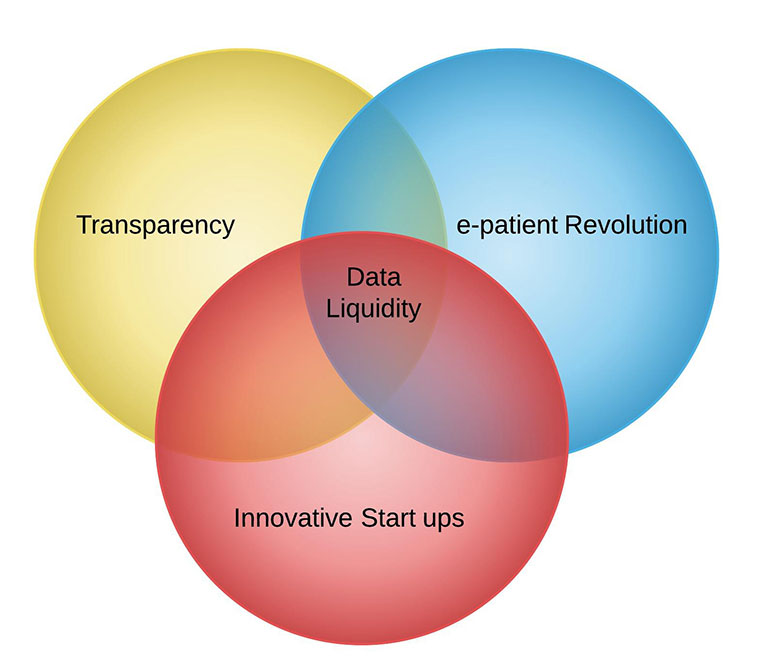 The Healthcare sector in India is ripe for an Airtel like impact where telecommunication saw its penetration to levels never imagined before and reached 100s of millions of people with 875 Million mobile phones in use as compared to 29 million landlines currently.
The Healthcare sector in India is ripe for an Airtel like impact where telecommunication saw its penetration to levels never imagined before and reached 100s of millions of people with 875 Million mobile phones in use as compared to 29 million landlines currently.
In the United States, there are more than 200 firms already working on building applications that use big data to develop applications and analytics tools that helps patients, doctors, insurance companies, and other healthcare stakeholders identify value and opportunities. However, before this step is reached, the Indian Healthcare industry has to go through a few more steps and these are happening in parallel right now which will create dataliquidity;
Transparency:
Healthcare institutions are still not ready for the required level of transparency
Many healthcare institutions are not ready for this level of transparency that is considered “normal” by the millennials. Until recently healthcare was delivered behind secure walls that kept information on the prices charged and diagnosis details opaque from public view. This is changing rapidly with the spread of social media.
What the doctors say and charged are discussed and analysed in social media, 2nd and 3rd opinions are sought and anything fishy goes viral. The only solution for hospitals and doctors is to embrace transparency, replace “cleaver” with “clear”.
e-patient revolution:
The age of paternalistic medicine is ending. The age of participatory medicine has begun.
Many doctors are still not ready to embrace this change. Even I have had a personal experience related to this; A doctor in France was visibly upset when I described to him the procedure I expected to be done, while he recommended another procedure which we went through with. However, after the surgery and several weeks of painful recovery, he hesitantly admitted that he should have done the presurgery process that I had described to him and wanted to redo the surgery! (I decided to redo the surgery with Dr. Adam at Fortis in Mauritius and it was a success even thought I had to go through another two weeks of recovery.) The difference in the approach of the two doctors was evident from the first visit itself. One sees the patients as ignorant while the other considers them to be a partner in the process. Eventually, patients will percolate to the latter.
Advocacy for patient engagement in the US, UK, mainland Europe, and well beyond is driven largely by the belief, backed by some evidence, that engaging patients will reduce healthcare costs through the avoidance of unnecessary investigation and treatment. Patient engagement is seen as a way to help health systems become sustainable. Some have argued that it is the “blockbuster drug of the century” and will deliver equivalent dividends.
Online patient communities where patients meet, talk, support, inform, and coach each other are empowering patients. At the same time, they also provide a rich and as yet largely untapped learning resource for health professionals. Examples include healthunlocked.com, healthtalkonline, rawarrior.com, and cancergrace.org.
Giving data access to patients, e-Patient Dave (www.epatientdave.com) is the first step in this process. Even though there is a lot of resistance for such platforms, change is taking place. Eventually, transparency and openness will win and will help in revolutionizing healthcare.
Innovative startups:
The deplorable gap in India’s healthcare infrastructure is an ocean of opportunities for innovative startups.
India has 750,000 doctors and 1.1 million nurses, yet practitioner density is about one-fourth that of America and less than half that of China. There is also a severe shortage of hospital beds and medical facilities in the country. Technology will build the huge bridge that needs to be built in India to lower the costs, improve the efficiency and improve the health care standard of a Billion Indians.
A very healthy sign today is the number of upcoming startups in the healthcare domain. Backed by impact investors such as Omidyar Network and other firms such as Seedfund, Helion, and Unitus, these companies are developing new business models for affordable care hospitals and remote diagnostic tools to reach rural communities.
Signs of early success are visible from such startups with some of them being:
- Vaatsalya, a hospital network focused on smaller cities, the cost of delivering a baby is as low as $30.
- Welcare has developed a low-cost retinal screening device that significantly reduces the cost.
- BioSense produces very affordable diagnostic tool for detecting anemia.
- Dhilcare, similarly produces very low cost ECG machines.
- Aravind Eye Hospital manufactures its own high-quality intraocular lenses, used in cataract surgery, for $2 apiece instead of buying them for $200 from international suppliers.
The three factors mentioned above (Lower costs, improve efficiency, and improve overall healthcare standard) will create the dataliquidity that is needed for big data firms to flourish and create innovative solutions.
Big Data companies in the US have already started this revolution, and similar opportunities in exist in India as well. Some Big Data driven innovative companies in the US include:
- Asthmapolis : GPS-enabled Tracker that monitor inhaler usage. Data obtained are providing insights and help in developing personalized treatments.
- Ginger.io : Moment and location information captured of those suffering from Diabetes and patterns recognized to predict and anxiety attack, detect that a patient is unwell etc
- mHealthCoach : Promotes treatment adherence through interactive APIs. It helps identify high-risk patients and deliver targeted messages or reminders.
Healthcare is a human right. What is happening right now is in the right direction, and will create better health for all in future. The future of healthcare is data rich and bright.

Related Posts: